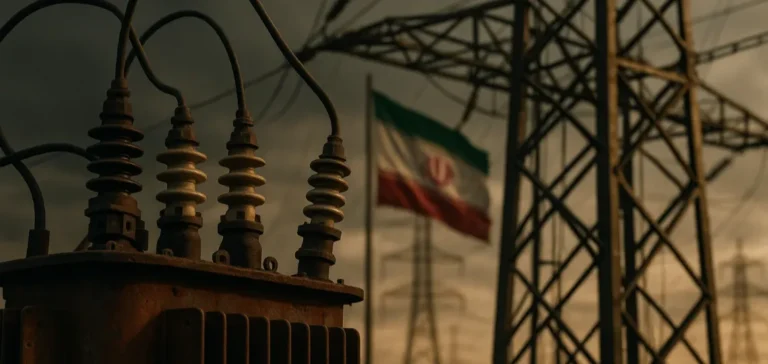Iran’s suspension of electricity exports to Iraq deprived Baghdad of about 1,400 megawatts (MW), nearly 10% of national peak demand. This cut compounds recurring summer shortages, as temperatures exceed 48 °C in several Iraqi provinces. At the same time, Iranian domestic demand reached a record peak of 77 gigawatts (GW), a historic level above the country’s effective capacity, estimated at around 85 GW installed but only 65 to 70 GW available due to outages and aging infrastructure.
A structurally dependent Iraqi market
Iraq consumes an average of 24,000 MW during summer, but its effective domestic capacity does not exceed 18,000 MW, leaving a structural deficit of 6,000 MW covered by imports and private generators. Historically, Iran supplied up to 1,200 to 1,500 MW of electricity and 40 million cubic meters of gas per day, together accounting for more than 40% of Iraq’s power needs. With the current suspension, Baghdad loses a crucial pillar of its energy balance, making outages almost inevitable in major cities.
Direct impact on the Iraqi grid
The Iranian cut immediately lowered the frequency of Iraq’s already unstable grid, triggering a nationwide blackout in early August. Provinces such as Basra, Dhi Qar, and Baghdad reported outages of 6 to 12 hours per day. According to Iraq’s Ministry of Electricity, technical losses reach 40% of power produced or imported, due to leaks, theft, and an outdated network. This structural inefficiency means that every MW lost from Iran translates into a larger deficit on the Iraqi side.
A context shaped by U.S. sanctions
In March 2025, the United States lifted the waiver that allowed Iraq to pay for Iranian electricity imports in dollars through escrow accounts. Only gas deliveries remain covered by an exemption. According to Iraqi government sources, more than $10 billion in accumulated bills to Iran remain unpaid. For Tehran, the lack of payment weighs as much as the surge in domestic consumption in the decision to suspend deliveries. This financial dimension, combined with sanctions, complicates any rapid resumption of flows.
Baghdad’s alternatives: interconnections and new agreements
To reduce its vulnerability, Baghdad is investing in regional interconnection projects. The connection to the Gulf Cooperation Council (GCC) via a 400 kilovolt (kV) line linking Kuwait to Basra is expected to deliver 500 to 600 MW by the end of the year. The infrastructure, financed at $220 million, is more than 75% complete. In parallel, a separate project with Saudi Arabia foresees an additional 1,000 MW in the medium term, while an agreement with Jordan aims for 150 MW in 2026, expandable to 900 MW by 2030. Turkey, for its part, doubled its deliveries to Iraq, reaching 800 MW in July, but these volumes remain marginal compared to the overall deficit.
An Iranian system under extreme pressure
In Iran, electricity consumption jumped 10% compared to last summer, mainly due to intensive air conditioning use. Technical losses on the grid are estimated at 15%, or about 11 GW lost in transmission, equivalent to the power demand of a country like Portugal. Adding to this fragility is the weight of cryptocurrency mining, which consumes between 2 and 3 GW according to local estimates, equivalent to two nuclear reactors. Authorities have seized more than 250,000 mining machines since 2021, but the phenomenon remains difficult to eradicate.
Tehran’s plans and ambitions
Iran’s Ministry of Energy has unveiled a plan to raise renewable capacity to 7 GW by March 2026, up from 1.8 GW currently. Ongoing projects include 850 solar plants totaling around 5,000 MW, with an expected investment of $3 billion mobilized through public-private partnerships. The government also announced a renovation program for 20 thermal power plants to convert single-cycle units into combined-cycle, with an expected gain of 5,000 MW. Despite these initiatives, feasibility remains uncertain given international sanctions restricting access to turbines and Western equipment.
An unstable regional equation
The electricity balance in the Middle East remains fragile. Iran must choose between supplying its neighbors and avoiding domestic blackouts, while Iraq seeks to diversify its sources without an immediate solution. Regional interconnection projects – estimated at more than 5 GW combined by 2030 – reflect Baghdad’s determination to reduce a dependence that exposes its economy and social stability. For energy market players, these shifts are redrawing the map of regional flows and could open greater space for Gulf producers at Tehran’s expense.






















